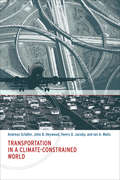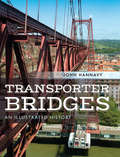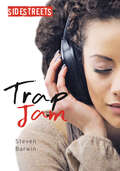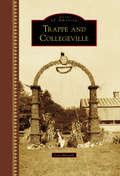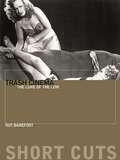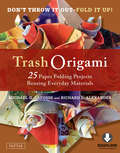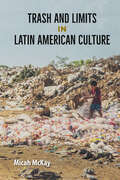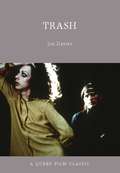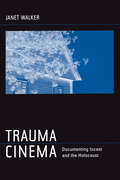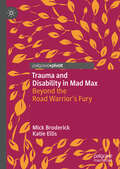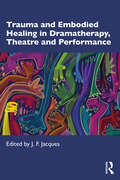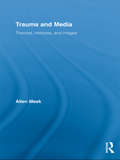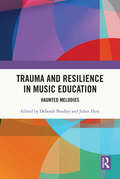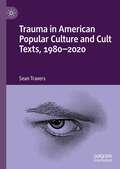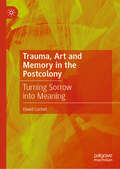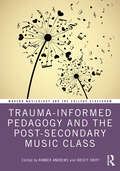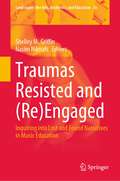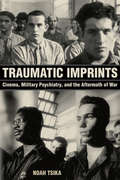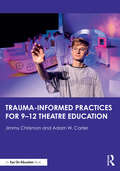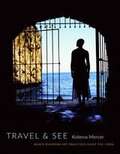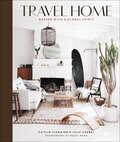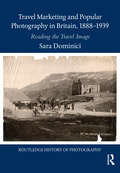- Table View
- List View
Transportation in a Climate-Constrained World (The\mit Press Ser.)
by Andreas Schafer John B. Heywood Henry D. Jacoby Ian A. WaitzA discussion of the opportunities and challenges involved mitigating greenhouse gas emissions from passenger travel.In the nineteenth century, horse transportation consumed vast amounts of land for hay production, and the intense traffic and ankle-deep manure created miserable living conditions in urban centers. The introduction of the horseless carriage solved many of these problems but has created others. Today another revolution in transportation seems overdue. Transportation consumes two-thirds of the world's petroleum and has become the largest contributor to global environmental change. Most of this increase in scale can be attributed to the strong desire for personal mobility that comes with economic growth. InTransportation in a Climate-Constrained World, the authors present the first integrated assessment of the factors affecting greenhouse gas (GHG) emissions from passenger transportation. They examine such topics as past and future travel demand; the influence of personal and business choices on passenger travel's climate impact; technologies and alternative fuels that may become available to mitigate GHG emissions from passenger transport; and policies that would promote a more sustainable transportation system. And most important, taking into account all of these options are taken together, they consider how to achieve a sustainable transportation system in the next thirty to fifty years.
Transporter Bridges: An Illustrated History
by John HannavyThis volume of original and historic photographs captures the story of the ingenious bridges that carried us from the Victorian era into modern times.With their moveable platforms designed to traverse busy waterways, Transporter Bridges served a brief but vital need from the late 19th century into the early 20th. Though many were planned, the huge increase in road transport quickly rendered them obsolete. In the end, fewer than thirty were ever completed across the world, with only nine still standing in their original form. But the transporter bridge appears to be entering a renaissance. In France and Argentina, restoration efforts are bringing life back to some of the original bridges. Meanwhile, proposals exist for three new bridges across France—at Nantes, Marseille and Brest—to replace some of those lost during and after the Second World War.This illustrated history captures the beauty of transporter bridges through hundreds of color photographs. The author combines his own modern images with many historic photographs and postcards chronicling the construction and operation of these unusual structures.
Trap Jam (Lorimer SideStreets)
by Steven BarwinOlivia spends her nights drumming in a band, hanging out in clubs and drinking, and her days hungover at school. When her bandmate Lucas catches Olivia talking to her friend Raymond in the women's washroom, he beats up Raymond in a jealous rage. When Lucas tells Olivia that Raymond's criminal brother is looking for them for payback, they go on the run together. Lucas keeps Olivia drunk and off-balance, telling her he loves her and pressuring her to have sex with him. When Olivia finally discovers that the story about Raymond's brother is a lie, she realizes she has to get out of Lucas's obsessive trap. Distributed in the U.S by Lerner Publishing Group.
Trappe and Collegeville (Images of America)
by Lisa MinardiLocated in the scenic Perkiomen Valley, the adjacent boroughs of Trappe and Collegeville have a rich and fascinating history. Trappe was founded in 1717 by German immigrant Jacob Schrack Sr., who ran a tavern known as the Trap, after which the village was named. Its most famous early residents were Lutheran patriarch Henry Melchior Muhlenberg and his sons Peter, a Revolutionary War general, and Frederick, first speaker of the US House of Representatives. Collegeville, initially known as Freeland, developed primarily in the 1800s following the completion of the Perkiomen Bridge in 1799. It was named after several early colleges, including Freeland Seminary, established in 1848, and the Pennsylvania Female College, established in 1851. These institutions were succeeded by Ursinus College in 1869. A pioneer in women’s education, Ursinus became coeducational in 1880. Trappe and Collegeville were formally incorporated as separate boroughs in 1896.
Trash Cinema: The Lure of the Low (Short Cuts)
by Guy BarefootThis volume explores the lower reaches of cinema and its paradoxical appeal. It looks at films from the B-movies of the 1930s to the mockbusters of today, and from the New York underground to the genre variations of Turkey's Yesilçam studios (and their YouTube afterlife). Critically examining the reasons for studying, denigrating, or celebrating the detritus of film history, it also considers the place of a trash aesthetic within and beyond 1960s American avant-garde and looks at the cult of trash in the fanzines of the 1980s. It draws on debates about cult, paracinema, and camp, arguing that trash cinema exists in relation to these but brings with it a particular history that includes the ordinary as well as the strange. Trash Cinema places these debates, and the strand of self-proclaimed low culture that emerged in the second half of the twentieth century, within a historical and international perspective. It focuses on American cinema history but addresses Eurotrash reception as well as the related field of garbology, examining trash cinema as a distinct but fluid category.
Trash Origami
by Richard L. Alexander Michael G. LafosseDon't dump your wastepaper into the garbage--it's time to fold! Famed origami artists and award-winning authors Michael G. LaFosse and Richard L. Alexander show you the way with Trash Origami. Chock full of 25 fun and innovative origami projects from their renowned Origamido Studio as well as many of the world's most talented paper folding designers--including Nick Robinson, Herman Van Goubergen and Rhona Geurkewitz, among others.The origami models presented in Trash Origami include designs made from old calendar pages, candy wrappers, envelopes, newspaper, postcards, paper grocery bags and more. Also provided is a guide to everyday materials that have the most folding potential-- leaving readers inspired to design and display their very own trash origami!
Trash Origami
by Richard L. Alexander Michael G. LafosseDon't dump your wastepaper into the garbage--it's time to fold! Famed origami artists and award-winning authors Michael G. LaFosse and Richard L. Alexander show you the way with Trash Origami. Chock full of 25 fun and innovative origami projects from their renowned Origamido Studio as well as many of the world's most talented paper folding designers--including Nick Robinson, Herman Van Goubergen and Rhona Geurkewitz, among others.The origami models presented in Trash Origami include designs made from old calendar pages, candy wrappers, envelopes, newspaper, postcards, paper grocery bags and more. The accompanying DVD will make the folding process clearer and aid folders of all levels. Also provided is a guide to everyday materials that have the most folding potential-- leaving readers inspired to design and display their very own trash origami!
Trash and Limits in Latin American Culture
by Micah McKayThe ecological, social, and aesthetic functions of garbage in literature and film from Argentina to Mexico This book looks at the role of waste in Latin American cultural texts from the twentieth and twenty-first centuries and makes the case for foregrounding trash as an object of analysis in literary and cultural studies in Spanish America and Brazil. By considering how writers and filmmakers engage with the theme, Micah McKay argues that garbage illuminates key limits related to the region’s experience with contemporary capitalism. Recognizing trash as an important social reality, McKay traces its appearance in a diverse range of products: novels and documentary films with dumps as settings, short stories whose main characters are garbage pickers, and works that portray writing as a process of piecing together found materials. McKay argues that waste and the problems it poses are key to understanding marginalization, political struggle, and the production of aesthetic value. Drawing on insights from material ecocriticism, discard studies, and biopolitics, McKay theorizes that trash opens a space of reflection on what it means to be human, the possibilities for building community amid catastrophe, gendered notions of labor and care, and the pitfalls of neoliberal environmentalism. McKay shows how trash in literature and film helps readers and viewers contemplate the limits of how we inhabit the planet. Publication of this work made possible by a Sustaining the Humanities through the American Rescue Plan grant from the National Endowment for the Humanities.
Trash-to-Treasure Papermaking: Make Your Own Recycled Paper from Newspapers & Magazines, Can & Bottle Labels, Disgarded Gift Wrap, Old Phone Books, Junk Mail, Comic Books, and More
by Arnold GrummerTransform junk mail, newspapers, and old phone books into beautiful handmade paper in just minutes! With a simple technique that requires only a blender and some water, Trash-to-Treasure Papermaking shows you how to create unique sheets in a variety of shapes, colors, textures, and sizes. Learn how to incorporate your handmade paper into diverse projects that include invitations, bound books, paper bowls, and ornaments. Let your creativity shine as you explore the fun and simple art of papermaking.
Trash: A Queer Film Classic
by Jon DaviesTrash, one of three inaugural titles in Arsenal Pulp Press' new film book series Queer Film Classics, delves into the legendary 1970 film that was arguably the greatest collaboration between director Paul Morrissey and producer Andy Warhol.<P> The film Trash is a down-and-out domestic melodrama about a decidedly eccentric couple: Joe, an impotent junkie (played by Warhol film regular Joe Dallesandro), and Holly, Joe's feisty and sexually frustrated girlfriend (played by trans Warhol superstar Holly Woodlawn). Joe is the hunky yet passive center around whom proud Holly orbits; while Morrissey intended to show that "there's no difference between a person using drugs and a piece of refuse," Woodlawn's incredible turn reverses his logic: she makes trash as precious as human beings.<P> The book examines the film in the context of Morrissey and Warhol's legendary partnership, with a special focus on Woodlawn's acclaimed performance: a glorious embodiment of "trash" and glamour that was so stunning, director George Cukor led a campaign (albeit unsuccessful) to win her an Oscar nomination.
Trauma Cinema: Documenting Incest and the Holocaust
by Janet WalkerTrauma Cinema focuses on a new breed of documentary films and videos that adopt catastrophe as their subject matter and trauma as their aesthetic. Incorporating oral testimony, home-movie footage, and documentary reenactment, these documentaries express the havoc trauma wreaks on history and memory. Janet Walker uses incest and the Holocaust as a double thematic focus and fiction films as a point of comparison. Her astute and original examination considers the Hollywood classic Kings Row and the television movie Sybil in relation to vanguard nonfiction works, including Errol Morris's Mr. Death, Lynn Hershman's video diaries, and the chilling genealogy of incest, Just, Melvin. Both incest and the Holocaust have also been featured in contemporary psychological literature on trauma and memory. The author employs theories of post traumatic stress disorder and histories of the so-called memory wars to illuminate the amnesias, fantasies, and mistakes in memory that must be taken into account, along with corroborated evidence, if we are to understand how personal and public historical meaning is made.Janet Walker’s engrossing narrative demonstrates that the past does not come down to us purely and simply through eyewitness accounts and tangible artifacts. Her incisive analysis exposes the frailty of memory in the face of disquieting events while her joint consideration of trauma cinema and psychological theorizing radically reconstructs the roadblocks at the intersection of catastrophe, memory, and historical representation.
Trauma and Disability in Mad Max: Beyond the Road Warrior’s Fury
by Katie Ellis Mick BroderickThis book explores the inter-relationship of disability and trauma in the Mad Max films (1979-2015). George Miller’s long-running series is replete with narratives and imagery of trauma, both physical and emotional, along with major and minor characters who are prominently disabled. The Mad Max movies foreground representations of the body – in devastating injury and its lasting effects – and in the broader social and historical contexts of trauma, disability, gender and myth.Over the franchise’s four-decade span significant social and cultural change has occurred globally. Many of the images of disability and trauma central to Max’s post-apocalyptic wasteland can be seen to represent these societal shifts, incorporating both decline and rejuvenation. These shifts include concerns with social, economic and political disintegration under late capitalism, projections of survival after nuclear war, and the impact of anthropogenic climate change.Drawing on screen production processes, textual analysis and reception studies this book interrogates the role of these representations of disability, trauma, gender and myth to offer an in-depth cultural analysis of the social critiques evident within the fantasies of Mad Max.
Trauma and Embodied Healing in Dramatherapy, Theatre and Performance
by J. F. JacquesThis edited volume explores the singularity of embodiment and somatic approaches in the healing of trauma from a dramatherapy, theatre and performance perspective.Collating voices from across the fields of dramatherapy, theatre and performance, this book examines how different interdisciplinary and intercultural approaches offer unique and unexplored perspectives on the body as a medium for the exploration, expression and resolution of chronic, acute and complex trauma as well as collective and intergenerational trauma. The diverse chapters highlight how the intersection between dramatherapy and body-based approaches in theatre and performance offers additional opportunities to explore and understand the creative, expressive and imaginative capacity of the body, and its application to the healing of trauma.The book will be of particular interest to dramatherapists and other creative and expressive arts therapists. It will also appeal to counsellors, psychotherapists, psychologists and theatre scholars.
Trauma and Media: Theories, Histories, and Images (Routledge Research in Cultural and Media Studies)
by Allen MeekThis book provides the first comprehensive account of trauma as a critical concept in the study of modern visual media, from Freud to the present day, explaining how contemporary trauma studies emerged from research on Holocaust representation in which the audiovisual testimony of survivors was posed as an authentic alternative to popular television and film dramatizations. It argues that the media coverage of 9/11 and the subsequent ‘war on terror,’ however, has revealed how the formation of communities of witness and commemoration around ‘traumatic events’ can perpetuate violence and inequality. The book explains how Benjamin, Adorno and Barthes, drawing from psychoanalysis, analyzed the roles of fantasy, ideology and collective identification in mass media, and began to understand trauma as an authentic experience of modernity. It proposes that the insights of these earlier theorists, along with more recent arguments by Derrida, Agamben and Zizek, continue to provide important perspectives on today’s politics of mediated shock and terror.
Trauma and Resilience in Music Education: Haunted Melodies
by Juliet Hess Deborah BradleyTrauma and Resilience in Music Education: Haunted Melodies considers the effects of trauma on both teachers and students in the music class- room, exploring music as a means for working through traumatic expe- riences and the role music education plays in trauma studies. The volume acknowledges the ubiquity of trauma in our society and its long-term deleterious effects while showcasing the singular ways music can serve as a support for those who struggle. In twelve contributed essays, authors examine theoretical perspectives and personal and societal traumas, providing a foundation for thinking about their implications in music education. Topics covered include: Philosophical, psychological, sociological, empirical, and narrative perspectives of trauma and resilience. How trauma-informed education practices might provide guidelines for music educators in schools and other settings Interrogations of how music and music education may be a source of trauma Distinguishing itself from other subjects—even the other arts—music may provide clues to the recovery of traumatic memory and act as a tool for releasing emotions and calming stresses. Trauma and Resilience in Music Education witnesses music’s unique abilities to reach people of all ages and empower them to process traumatic experiences, providing a vital resource for music educators and researchers.
Trauma in American Popular Culture and Cult Texts, 1980-2020
by Sean TraversThis book examines trauma in late twentieth- and twenty-first century American popular culture. Trauma has become a central paradigm for reading contemporary American culture. Since the early 1980s, an extensive range of genres increasingly feature traumatised protagonists and traumatic events. From traumatised superheroes in Hollywood blockbusters to apocalyptic-themed television series, trauma narratives abound. Although trauma is predominantly associated with high culture, this project shows how popular culture has become the most productive and innovative area of trauma representation in America. Examining film, television, animation, video games and cult texts, this book develops a series of original paradigms through which to understand trauma in popular culture. These include: popular trauma texts’ engagement with postmodern perspectives, formal techniques termed ‘competitive narration’, ‘polynarration’ and ‘sceptical scriptotherapy’, and perpetrator trauma in metafictional games.
Trauma, Art and Memory in the Postcolony: Turning Sorrow into Meaning
by David CorbetThis wide-ranging book provides a scholarly account of recent and contemporary memorial and counter-memorial practices occurring in the visual arts, across diverse postcolonial topologies and imaginaries. The emphasis is on commemorative creative practices and responses to traumatic events of recent times, within and beyond the Museum. This major survey encompasses discourses on perception, affect and trauma in the visual arts; commissioned civic art and memorial architecture; activist and socially-engaged art projects; creative praxis; and expressions of minority and First Nations cultural resilience. The book offers insights into contemporary exhibitionary practices; decolonial methodologies; and spatial politics, with a significant focus on art’s ability to reveal and reactivate silenced histories, sites and ‘non-places’. It will be of great interest to students, researchers and subject experts alike, across the fields of visual arts, architecture and urban planning; cultural and memory studies; and trauma and affect studies; contextualising the work of artists and curators within some of the most urgent socio-political, environmental and philosophical debates of the twenty-first century.
Trauma-Informed Pedagogy and the Post-Secondary Music Class (Modern Musicology and the College Classroom)
by Kimber Andrews Kristy SwiftTrauma-Informed Pedagogy and the Post-Secondary Music Class explores the theory and practice of teaching and learning in a traumatized world and aims to support instructors in guiding students and walking with them through challenges that impact learning. With analysis contextualized within definitions of trauma, critical theoretical trauma studies, and clinical understandings of the causes and effects of trauma on the brain and nervous system, the book offers ways to empower faculty and students to build classrooms where it is safe enough to address the stress and trauma of learning. Bringing together a unique multidisciplinary group of contributors, this book includes perspectives from both music faculty and mental health counseling specialists.The volume engages music scholars and educators in higher education with scholarship on trauma-informed pedagogy, provides examples of how to introduce trauma-informed practices into music courses, explores how trauma-informed practices can increase both faculty and student well-being, and offers practical materials such as syllabi and assignments that instructors can implement in their classes. Reaching across disciplinary boundaries to contribute to an emerging body of research, teaching, and learning, this is a vital collection for educators across music higher education.
Traumas Resisted and: Inquiring into Lost and Found Narratives in Music Education (Landscapes: the Arts, Aesthetics, and Education #36)
by Shelley M. Griffin Nasim NiknafsThis book focuses on the traumatic experiences within and through music that individuals and collectives face, while considering ways in which they (re)engage with their traumas in educational settings. The chapters delve into the physical, psychological, philosophical, sociological, and political aspects, as they relate to the reciprocal influences of trauma on musical practices and education. Readers are immersed in topics related to societal violence, physical injuries, grief, separation, loss, death, and ways of working through these in educational and artistic situations. In the introductory chapter, the co-editors draw attention to theoretical matters related to trauma through narrative inquiry in music education. The first section of the book, Separation Revisited, brings together notions of separation, focusing on how loss is emotionally and physically manifested when death, grief, and bodily injury are experienced. In the second section, (Re)Engaging with Lost and Found, readers are encouraged to imagine new possibilities considering trauma and loss in educational and musical spaces. These pieces offer deliberate ruminations moving the discourse toward (re)engagement in and through music education and artistic contexts. The co-editors conclude the book by drawing attention to narrative inquiry’s double-edged nature in stories of trauma and how the retelling of lost and found narratives offers a way to imagine lives otherwise—lives not smothered by grief and horror—through the conceivable reliving of unfathomable stories of experience. This book emerges from the 7th International Conference on Narrative Inquiry in Music Education (NIME7), October 2020, co-hosted by Brock University, Faculty of Education and the University of Toronto, Faculty of Music, Ontario, Canada.
Traumatic Imprints: Cinema, Military Psychiatry, and the Aftermath of War
by Noah TsikaForced to contend with unprecedented levels of psychological trauma during World War II, the United States military began sponsoring a series of nontheatrical films designed to educate and even rehabilitate soldiers and civilians alike. Traumatic Imprints traces the development of psychiatric and psychotherapeutic approaches to wartime trauma by the United States military, along with links to formal and narrative developments in military and civilian filmmaking. Offering close readings of a series of films alongside analysis of period scholarship in psychiatry and bolstered by research in trauma theory and documentary studies, Noah Tsika argues that trauma was foundational in postwar American culture. Examining wartime and postwar debates about the use of cinema as a vehicle for studying, publicizing, and even what has been termed “working through” war trauma, this book is an original contribution to scholarship on the military-industrial complex.
Trauma–Informed Practices for 9-12 Theatre Education
by Jimmy Chrismon Adam W. CarterThis resource bridges the worlds of education, mental health, and the performing arts to offer a comprehensive roadmap for 9–12 theatre educators looking to promote safe, supportive, and creative spaces for their students. Written by a seasoned theatre educator and a licensed mental health clinician, this book explores trauma-informed teaching techniques tailored specifically for theatre classrooms, encompassing both acting and production processes. Chapters cover a broad range of topics, from fostering resilience in students to collaborating with caregivers, administrators, and communities across the educational journey. The authors introduce essential concepts such as intimacy direction and consent, ensuring ethical and inclusive practices. They also provide strategies for teachers to prioritize their own self-care. Core themes and objectives include: trauma-informed teaching, holistic theatre production, community engagement, ethical theatre practices, and educator wellness. Packed with practical exercises for exploration, discussion questions for book studies, and meticulously researched insights, this resource strikes a balance between therapeutic guidance and professional development. Ideal for 9–12 theatre educators in drama classrooms, after-school programs, and more, this guide equips you with the tools to support students who may have experienced trauma, empowering them in performing arts environments while maintaining healthy boundaries.
Travel & See: Black Diaspora Art Practices since the 1980s
by Kobena MercerOver the years, Kobena Mercer has critically illuminated the visual innovations of African American and black British artists. In Travel & See he presents a diasporic model of criticism that gives close attention to aesthetic strategies while tracing the shifting political and cultural contexts in which black visual art circulates. In eighteen essays, which cover the period from 1992 to 2012 and discuss such leading artists as Isaac Julien, Renée Green, Kerry James Marshall, and Yinka Shonibare, Mercer provides nothing less than a counternarrative of global contemporary art that reveals how the "dialogical principle" of cross-cultural interaction not only has transformed commonplace perceptions of blackness today but challenges us to rethink the entangled history of modernism as well.
Travel Home: Design with a Global Spirit
by Caitlin Flemming Julie Goebel“A peek inside the homes of tastemakers . . . A masterclass in how to infuse the ideas and finds you scoop up on the road into your digs back home.” —ChairishA road map for bringing far-flung design ideas back home, Travel Home shows us how to curate interiors that reflect our favorite places and experiences in ways that are beautiful and authentic. Touring the homes of leaders in global design who share a deep affection for travel, the book explores interiors with influences as widespread as Marrakesh, Paris, Cuba, Tokyo, Portugal, and beyond. Vivid photography is supplemented with insightful essays, interviews, and hardworking tips for cultivating your own global home. For globetrotters and armchair travelers alike, Travel Home showcases the interplay between travel and design, revealing how we can take inspiration from the beauty we experience in the world and bring it into our everyday lives. “The book is a study of how travel informs our taste—and a beautiful illustration of the creative potential a mother-daughter partnership can yield.” —goop “Upon finishing Travel Home I felt inspired in the same way that I feel inspired after a big trip. It’s a book you’re going to want to take notes in, take pictures of, and share with your friends. It will be a book very well loved.” —Justina Blakeney, designer and New York Times-bestselling author of Jungalow“There are so many books about interiors, but this book is a genuine opportunity to get to know the people and the mentality behind their spaces.” —Nate Berkus and Jeremiah Brent, authors and television stars on Nate & Jeremiah by Design
Travel Marketing and Popular Photography in Britain, 1888–1939: Reading the Travel Image (Routledge History of Photography)
by Sara DominiciThis book explores how popular photography influenced the representation of travel in Britain in the period from the Kodak-led emergence of compact cameras in 1888, to 1939. The book examines the implications of people’s increasing familiarity with the language and possibilities of photography on the representation of travel as educational concerns gave way to commercial imperatives. Sara Dominici takes as a touchstone the first fifty years of activity of the Polytechnic Touring Association (PTA), a London-based philanthropic-turned-commercial travel firm. As the book reveals, the relationship between popular photography and travel marketing was shaped by the different desires and expectations that consumers and institutions bestowed on photography: this was the struggle for the interpretation of the travel image.
Travel Origami
by Cindy NgIn her new book, Travel Origami, author Cindy Ng shows you how to take the paper souvenirs you collect on your travels and turn them into beautiful and useful folded origami objects that serve as visible mementoes! Use those postcards, street maps, tickets and souvenirs and convert them into artful memories that can last a lifetime. Whether you are a world traveler or a local vacationer, Travel Origami gives you 24 easy-to-fold origami projects that are fun to make and fabulous to display in your home. Foolproof step-by-step instructions show you how to fold your paper collections into special items you can wear, carry, hang on your wall, or give to a traveling companion as a special keepsake. 24 fun and functional travel keepsakes include: Lampshade Photo frame Jewelry Wreath This book is the perfect way to stretch your adventures into hours of memory-making fun while reminiscing with family and friends.
